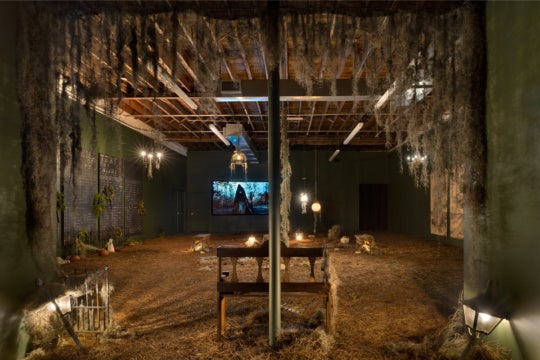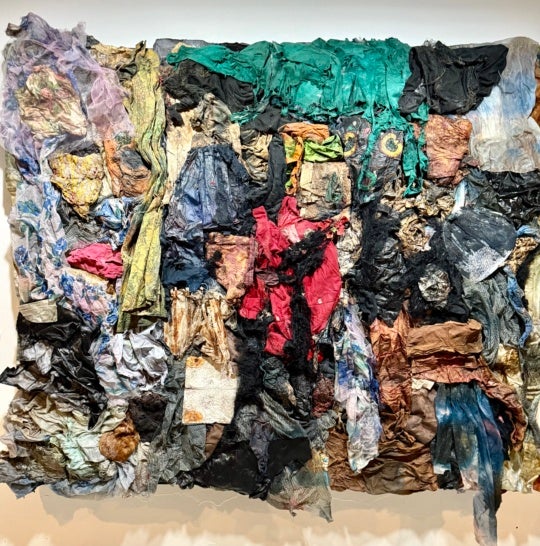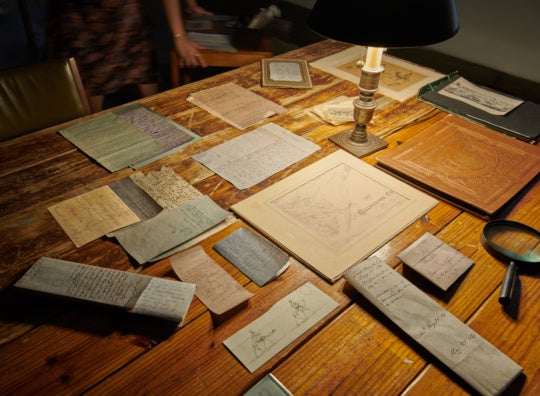
To see James Nares’s video Street and the street photography of Helen Levitt side by side is like peering into a mirror infinitely reflecting another. The exhibitions, on view through September 21 at the Jepson Center in Savannah, present a changing culture through signs: The clothes, graffiti, phone booths, street vendors, and Coca-Cola advertisements in Levitt’s photographs give way to the cell phones, video game posters, H&M bags, and Starbucks coffee cups of Street. Street, a 2011 video that garnered much acclaim when shown at New York’s Metropolitan Museum of Art in 2013, pays homage to Levitt’s street photography: Its people, products, structures, and even its medium are the culmination of decades of an often-documented social and cultural history. Like Levitt and her predecessors the Miles Brothers, whose works served as an inspiration for Street, Nares records everyday life in an objective, candid way that immortalizes scenes many people would overlook.

At times, the images in Street are so abstracted that they become decontextualized, and, as with street photography, context is left to the viewer’s imagination. The dual exhibition begins with Levitt’s early photography and grainy 1952 film In the Street and ends with Nares’s 61-minute, high-definition, slow-motion Street, which is separated from Levitt’s work by a lonely white wall—and, as is fitting, all in the museum’s Levitt Gallery.
In any form of documentary art, the artist must acknowledge his or her presence in the work. In this case, Nares is more the observer and Levitt the participant. In Street, people ignore the camera, purposefully and obliviously. Those moments when the subject does lock eyes with the camera become heartwarming, uncomfortable, and sometimes accusatory—and I feel voyeuristic, as if I’ve intruded in some way. Although it can be argued that people are always conscious of the presence of surveillance systems (see Panopticism), Nares—who filmed Street out the window of a moving van driving around Manhattan—and, by extension, the viewer, is invasive.

On the other hand, there is a moment in In the Street when children vie for the spotlight, jumping in front of each other until their noses almost touch the camera. Levitt’s role as filmmaker is apparent throughout—in the film’s static shots, composed narratives, and interaction with the subjects.
The silence of Levitt’s film is present in Nares’s video, despite Street’s high-definition resolution, color, large crowds, and constant movement. There is great distance, physical and psychic, between Nares and his subject. His method of filming indicates interaction in today’s society—fast, changing, and indirect. Nares’s New York is a reflection of Levitt’s New York, a place where life is, as a New York Times reviewer described Street in 2012, “stationary but shifting.”
Levitt and Nares urge the viewer to recognize that every moment is momentous. When placed next to Levitt’s iconic 20th-century street photography, Street becomes a stepping stone in a long history of documentary images, mirroring times past and times to come. Nares takes Levitt’s verism and pushes it into hyperreality, creating a world so true that it becomes nearly unrecognizable. Both take the viewer on a journey from heightened perception to changing perspective, where, by the end, it is apparent that the viewer is just as important as the viewed.





